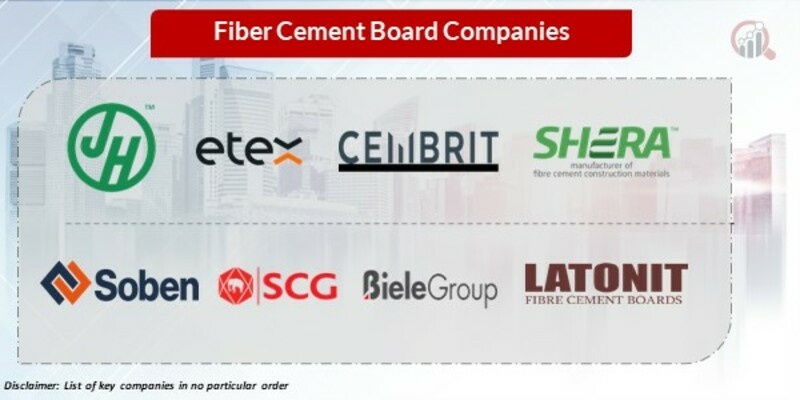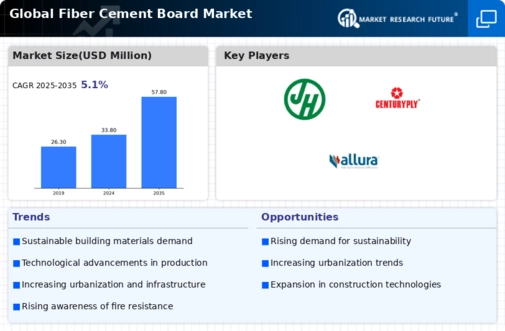Top Industry Leaders in the Fiber Cement Board Market

Fiber Cement Boards Market
Fiber cement boards, those unsung heroes of modern construction, silently stand at the core of countless structures, from towering skyscrapers to cozy cottages. These versatile, durable, and weather-resistant composites are witnessing a surge in demand, propelling the fiber cement board market towards exciting frontiers.
Strategies Building a Stronger Foundation:
-
Product Diversification and Niche Expertise: Leading manufacturers are expanding their portfolios beyond traditional flat boards, offering pre-cut panels, siding planks, and decorative options, catering to diverse architectural needs and aesthetic preferences.
-
Green Building Focus: Responding to sustainability concerns, companies are employing recycled materials, minimizing reliance on virgin wood pulp, and developing biodegradable fiber binders, aligning with eco-conscious construction practices.
-
Technological Innovation: Automation in board production, advanced fire-retardant formulations, and lightweight board designs optimize manufacturing, enhance safety, and improve thermal insulation properties.
-
Geographical Expansion and Market Penetration: Established players are venturing into emerging markets like Southeast Asia and Latin America, while strengthening their presence in developed regions through strategic acquisitions and local partnerships.
-
Customer-Centric Approach: Providing comprehensive technical support, installation training programs, and warranty extension options builds trust and fosters long-term customer relationships. Customization options and tailored solutions cater to specific project requirements.
Factors Forging Market Dominance:
-
Brand Reputation and Quality: A proven track record of delivering high-quality boards with consistent performance, adherence to international standards, and fire-resistance ratings builds trust and attracts repeat customers.
-
Product Range and Application Focus: Offering a diverse range of boards for various applications broadens market reach. Specializing in specific sectors like roof cladding or interior partitioning can lead to niche leadership.
-
Production Capacity and Supply Chain Efficiency: Streamlined manufacturing processes, optimized inventory management, and reliable logistics infrastructure ensure timely delivery and minimize project delays.
-
Research and Development: Investing in R&D fosters innovation and allows companies to stay ahead of the curve with environmentally friendly materials, improved board properties, and cost-effective production methods.
-
Regulatory Compliance and Certifications: Adherence to stringent safety regulations and environmental standards like ASTM and LEED demonstrates commitment to quality and responsible manufacturing.
Key Players:
- James Hardie Europe GmbH (Australia)
- Etex (Belgium)
- Cembrit Holding A/S (Denmark)
- SHERA (Thailand)
- Soben International (Asia Pacific) Ltd (Hong Kong)
- SCG (Thailand)
- Biele Group (Spain)
- LATONIT (Russia)
- NICHIHA (Japan)
- Everest Industries (India)
Recent Developments:
-
August 2023: James Hardie Industries unveils a new line of fire-resistant fiber cement boards specifically designed for high-rise building applications.
-
September 2023: Etex Group partners with a waste management company to develop a closed-loop recycling system for used fiber cement board scraps, minimizing environmental impact.
-
October 2023: The American Society of Civil Engineers releases a report highlighting the need for increased investment in building envelope upgrades, potentially favoring the adoption of durable and weather-resistant fiber cement boards.
-
January 2020: James Hardie Building Products Inc. debuted 700 Color plus Technology finish fiber cement under the James Hardies' Dream Collection to expand the fiber cement product portfolio's vast range of color options.
-
July 2021: Nichiha Corporation expanded its production facility in Macon-Bibb County, Georgia, by investing USD 120 million to increase its operations. This strategic move is designed to help the corporation increase demand for its products in the U.S.'s southeastern area.









